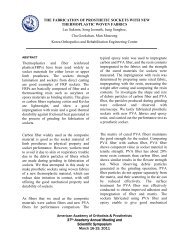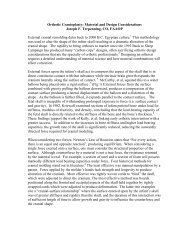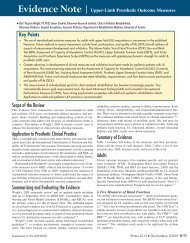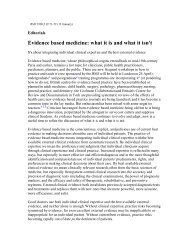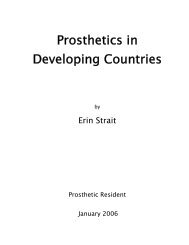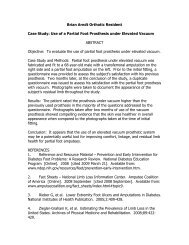vacuum-formed removable rigid dressing compared with ...
vacuum-formed removable rigid dressing compared with ...
vacuum-formed removable rigid dressing compared with ...
Create successful ePaper yourself
Turn your PDF publications into a flip-book with our unique Google optimized e-Paper software.
VACUUM-FORMED REMOVABLE RIGID DRESSING COMPARED WITH<br />
CONVENTIONAL RIGID DRESSING AFTER TRANSTIBIAL AMPUTATION:<br />
SIMILAR OUTCOME IN A RANDOMIZED CONTROLLED TRIAL IN 27<br />
PATIENTS<br />
Anton Johannesson CPO<br />
Department of Clinical and Experimental Medicine, Linköping University, Linköping,<br />
Sweden<br />
Gert-Uno Larsson MD<br />
Department of Orthopedics, Hässleholm and Kristianstad Hospitals, Kristianstad,<br />
Sweden<br />
Tommy Öberg<br />
Department of Rehabilitation, School of Health Sciences, Jönköping University, Jönköping,<br />
Sweden<br />
Isam Atroshi MD<br />
Department of Clinical Sciences, Lund University, Lund, and Department of Orthopedics,<br />
Hässleholm and Kristianstad Hospitals, Hässleholm,<br />
Sweden<br />
Following transtibial amputations, various types of <strong>dressing</strong>s have been used to<br />
promote uncomplicated wound healing, pain control, and shaping of the residual limb, which<br />
are the factors that facilitate rapid prosthetic fitting and rehabilitation. No consensus exists on<br />
whether this is best achieved <strong>with</strong> the use of <strong>rigid</strong> or soft <strong>dressing</strong> [1]. Rigid and semi-<strong>rigid</strong><br />
<strong>dressing</strong>s have been reported to have advantages related to better wound healing and volume<br />
control, protection against injury during falls, lower risk of knee contracture, reduced time in<br />
hospital and reduced time to prosthetic fitting [2]. The method of applying a <strong>rigid</strong> <strong>dressing</strong><br />
using plaster of Paris directly after surgery has been used for many years <strong>with</strong> the primary<br />
goal of containing volume and preventing excessive edema [1]. In general, the practice for<br />
application of <strong>rigid</strong> <strong>dressing</strong>s has been to use a cast for 1 to 3 weeks (depending on the<br />
rehabilitation strategy used and the kind of compression therapy applied) and, if needed for<br />
more than 1 week, to replace the cast in order to accommodate for volume changes [1].<br />
Despite the reported advantages of <strong>rigid</strong> <strong>dressing</strong>s the most widely used type of<br />
<strong>dressing</strong> following transtibial amputation still is soft <strong>dressing</strong> [3;4]. The main goal of using<br />
soft <strong>dressing</strong> is to absorb the fluid from the wound and to prevent edema <strong>with</strong> a compressive<br />
elastic bandage. Elastic bandages have the advantage of being inexpensive but may be<br />
associated <strong>with</strong> serious problems [5]. To date, no study has shown that soft <strong>dressing</strong>s give<br />
superior results than <strong>rigid</strong> or semi-<strong>rigid</strong> <strong>dressing</strong>s [1].<br />
Factors that limit the use of <strong>rigid</strong> <strong>dressing</strong>s are believed to be related to<br />
application difficulties (surgeons may need assistance during application), time consumption<br />
(time for application, prolonged anesthesia and cleaning), difficulty in wound inspection<br />
(surgeons may prefer to have easy access to the wound especially if complications occur) and<br />
risk of pressure ulcers or pressure on the patella [3;6]. Therefore, a <strong>removable</strong> <strong>rigid</strong> <strong>dressing</strong><br />
would address these problems while maintaining the advantages of the plaster of Paris<br />
<strong>dressing</strong>.
2<br />
A <strong>vacuum</strong>-<strong>formed</strong> <strong>removable</strong> <strong>rigid</strong> <strong>dressing</strong>, the ORD (ÖSSUR Inc.,<br />
Reykjavik, Iceland) has been developed for use after transtibial amputation [7] (Figure 1-3).<br />
The purpose of this randomized controlled trial was to compare the ORD <strong>with</strong> a conventional<br />
plaster of Paris <strong>rigid</strong> <strong>dressing</strong> (CRD) in patients undergoing transtibial amputation because of<br />
peripheral vascular disease, <strong>with</strong> regard to time to prosthetic fitting and function <strong>with</strong> the<br />
prosthesis.<br />
Figure 1. The ORD after the removal of all air and its<br />
application completed<br />
Figure 2. The ORD after the removal of all air and its<br />
application completed<br />
From January 2003 through July 2005, patients<br />
scheduled for transtibial amputation at one<br />
orthopedic department were screened for<br />
enrolment in this study. The department is the<br />
only medical facility where amputation surgery<br />
is per<strong>formed</strong> in the region of Northeastern Skåne<br />
(population 170,000) in Sweden. The inclusion<br />
criteria were transtibial amputation because of<br />
peripheral vascular disease <strong>with</strong> or <strong>with</strong>out<br />
diabetes and willingness to participate in the<br />
study. The exclusion criteria were inability to<br />
Figure 3. The ORD opened for wound inspection<br />
walk, severe dementia, knee contracture,<br />
fracture or severe cerebrovascular, neurological<br />
or other medical disorders that could affect rehabilitation, severe peripheral vascular disease<br />
involving the contralateral lower limb, or inability to speak Swedish.<br />
Patients were randomized at surgery to receive ORD or conventional plaster of Paris <strong>rigid</strong><br />
<strong>dressing</strong> for 5 to 7 days followed by compression therapy using silicone liner. Primary<br />
outcome measure was time to prosthetic fitting and secondary outcome measures included<br />
function <strong>with</strong> the prosthesis 3 months after amputation measured <strong>with</strong> the Locomotive<br />
Capability Index (LCI) [8] and the Timed “Up and Go” (TUG) test [9]. All patients received<br />
prosthesis <strong>with</strong> a total surface bearing socket (ICEX, ÖSSUR Inc., Reykjavik, Iceland).<br />
The primary outcome measure was the number of days from amputation to prosthetic fitting.<br />
The secondary outcome measures were the wound healing rate, functional outcome as<br />
measured <strong>with</strong> the LCI and TUG test at 3 months, need for socket changes during the first<br />
year, and the rate of returning to previous dwelling at 1 year.
3<br />
Of 27 patients randomized (15 ORD and 12 CRD) prosthetic fitting was achieved in 23<br />
patients (mean age 76, range 43 to 91 years); 13 (9 men) in the ORD group and 10 (5 men) in<br />
the CRD group (Table 1).<br />
Table 1. Characteristics of the patients in the two groups<br />
ORD CRD<br />
(n = 13) (n = 10)<br />
Age, mean (range) yrs 76 (45 – 91) 76 (43 – 89)<br />
Sex, male: female 9:4 5:5<br />
Smoker, never : current : previous 5:2:6 6:2:2<br />
Diabetes mellitus 6 6<br />
Other medical conditions<br />
Cardiac disease 12 8<br />
Neurological disease 4 2<br />
Hip or knee disease 2 2<br />
Other joint disease 1 3<br />
Hip replacement 2 1<br />
Wound healing was similar in both<br />
groups. Mean time to prosthetic fitting<br />
was 37 days (range 26-54) in the ORD<br />
and 34 days (21-47) in the CRD group<br />
(adjusted mean difference 3, 95%<br />
confidence interval -3 to 9). At 3<br />
months, mean LCI was 28.2 (range 6-<br />
42) in the ORD and 25.3 (2-41) in the<br />
CRD group (mean difference -0.1, 95%<br />
CI -8.5 to 8.2) and mean TUG was 41<br />
seconds (10-92) and 29 (10-47),<br />
respectively (mean difference 14, 95%<br />
CI -2 to 30).<br />
The number of patients in our study was small, which raises the possibility of a type-2 error as<br />
a cause of not finding statistically significant differences. We have, however, shown the 95%<br />
confidence intervals for the differences between the two groups in days to prosthetic fitting<br />
and results of the functional tests and these suggest that a potential difference in outcomes in<br />
favour of conventional <strong>rigid</strong> <strong>dressing</strong> may not be large.<br />
Table 2. Outcome regarding days to prosthetic fitting and function <strong>with</strong> prosthesis<br />
ORD CRD Mean difference<br />
(n = 13)ª (n = 10) (95% CI) b<br />
Outcome variable Mean (SD) Median Mean (SD) Median<br />
Time to prosthetic fitting (days) 37 (7) 37 34 (8) 33 4 (-2 to 11)<br />
LCI (points)<br />
Total 28 (14) 32 25 (13) 22 -0.1 (-8.5 to 8.2)<br />
Basic 17 (6) 20 16 (6) 17 -1.1 (-4.5 to 2.3)<br />
Advanced 12 (9) 12 9 (7) 7 0.9 (-4.7 to 6.6)<br />
TUG (seconds) 41 (24) 36 29 (14) 33 14 (-2 to 30)<br />
ª (n = 12) for analyses of LCI and TUG (1 patient died before follow-up)<br />
b Adjusted for age and sex<br />
O, <strong>vacuum</strong>-<strong>formed</strong> <strong>rigid</strong> <strong>dressing</strong>; C, conventional <strong>rigid</strong> <strong>dressing</strong>; LCI, locomotor capability index (higher score,<br />
0 to 42 for Total and 0 to 21 for Basic and Advanced, indicates better function <strong>with</strong> prosthesis); TUG, Timed<br />
“Up and Go” (rise from chair, walk 3 meters and return to chair)<br />
Generalizability of the findings is supported by the screening for eligibility of all<br />
patients from a relatively large general population, the random allocation of participants, and<br />
the blinded assessment.<br />
In conclusion this randomized trial comparing <strong>vacuum</strong>-<strong>formed</strong> <strong>removable</strong> <strong>rigid</strong> <strong>dressing</strong> <strong>with</strong><br />
conventional plaster of Paris <strong>rigid</strong> <strong>dressing</strong> after transtibial amputation showed that the two
4<br />
<strong>dressing</strong>s appear to yield similar results regarding functional outcome after 3 months <strong>with</strong> no<br />
statistically significant differences regarding wound healing, time to prosthetic fitting,<br />
functional outcome, rate of socket changes during the first year or return to previous dwelling<br />
at 1 year. An easily applicable and <strong>removable</strong> <strong>vacuum</strong>-<strong>formed</strong> <strong>rigid</strong> <strong>dressing</strong> can be favourably<br />
used as an alternative to conventional cast <strong>rigid</strong> <strong>dressing</strong> after transtibial amputation.<br />
Reference List<br />
(1) Smith DG, McFarland LV, Sangeorzan BJ, Reiber GE, Czerniecki JM: Postoperative<br />
<strong>dressing</strong> and management strategies for transtibial amputations: a critical review. J<br />
Rehabil Res Dev 2003; 40(3):213-224.<br />
(2) Nawijn SE, van der LH, Emmelot CH, Hofstad CJ: Stump management after transtibial<br />
amputation: a systematic review. Prosthet Orthot Int 2005; 29(1):13-26.<br />
(3) Choudhury SR, Reiber GE, Pecoraro JA, Czerniecki JM, Smith DG, Sangeorzan BJ:<br />
Postoperative management of transtibial amputations in VA hospitals. J Rehabil Res<br />
Dev 2001; 38(3):293-298.<br />
(4) Dormandy J, Belcher G, Broos P, Eikelboom B, Laszlo G, Konrad P, Moggi L,<br />
Mueller U: Prospective study of 713 below-knee amputations for ischaemia and the<br />
effect of a prostacyclin analogue on healing: Hawaii Study Group. Br J Surg 1994;<br />
81(1):33-37.<br />
(5) Horne G, Abramowicz J: The management of healing problems in the dysvascular<br />
amputee. Prosthet Orthot Int 1982; 6(1):38-40.<br />
(6) Cohen SI, Goldman LD, Salzman EW, Glotzer DJ: The deleterious effect of<br />
immediate postoperative prothesis in below-knee amputation for ischemic disease.<br />
Surgery 1974; 76(6):992-1001.<br />
(7) Johannesson A, Larsson GU, Oberg T: From major amputation to prosthetic outcome:<br />
a prospective study of 190 patients in a defined population. Prosthet Orthot Int 2004;<br />
28(1):9-21.<br />
(8) Grise MC, Gauthier-Gagnon C, Martineau GG: Prosthetic profile of people <strong>with</strong><br />
lower extremity amputation: conception and design of a follow-up questionnaire.<br />
Arch Phys Med Rehabil 1993; 74(8):862-870.<br />
(9) Schoppen T, Boonstra A, Groothoff JW, de VJ, Goeken LN, Eisma WH: The Timed<br />
"up and go" test: reliability and validity in persons <strong>with</strong> unilateral lower limb<br />
amputation. Arch Phys Med Rehabil 1999; 80(7):825-828.



